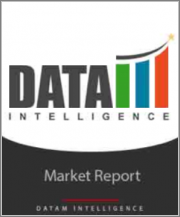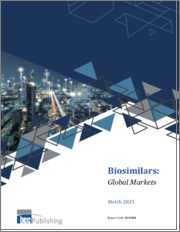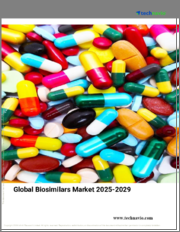
|
시장보고서
상품코드
1297769
세계의 바이오시밀러 시장(2023-2030년)Global Biosimilars Market - 2023-2030 |
||||||
시장 개요
바이오시밀러 세계 시장은 2022년 301억 달러, 2030년 767억 달러에 달할 것으로 예상되며, 수익성 있는 성장을 보일 것으로 예상됩니다. 바이오시밀러 세계 시장은 2023년부터 2030년까지 예측 기간 동안 12.8%의 CAGR을 보일 것으로 예상됩니다.
바이오시밀러 의약품은 동일한 치료 효과를 유지하면서 더 저렴한 대안을 제공함으로써 환자의 생물학적 치료 접근성을 향상시킬 수 있는 기회를 제공합니다. 바이오시밀러는 헬스케어의 지속가능성을 높이고 암, 자가면역질환, 만성 염증성 질환 등 다양한 질병을 앓고 있는 환자들에게 더 많은 치료법을 제공하는 데 필수적입니다.
시장 역학
만성질환의 증가로 인해 예측 기간 동안 바이오시밀러 세계 시장 성장이 촉진되고 있습니다.
전 세계적으로 암, 자가면역질환, 당뇨병과 같은 만성질환의 유병률이 증가하고 있습니다. 바이오시밀러는 특정 질환에 대한 경제적인 치료 옵션을 제공함으로써 환자의 생명을 구하는 약물에 대한 접근성을 향상시킵니다. 바이오시밀러에 대한 수요는 만성 질환의 유병률 증가에 의해 주도되고 있습니다.
WHO의 2022년 9월 데이터 보고에 따르면, NCD로 인한 사망의 대부분(연간 1,790만 명)은 심혈관 질환으로 인한 것이며, 악성 종양(930만 명), 만성 호흡기 질환(410만 명), 당뇨병(당뇨병으로 인한 신장 질환으로 인한 사망자 200만 명)이 뒤를 잇고 있습니다.
FDA의 바이오시밀러 의약품 승인은 세계 바이오시밀러 의약품 시장에 미래 성장 기회를 가져다 줄 것입니다.
미국 식품의약국(FDA)은 바이오시밀러 의약품을 승인하고 안전하고 효율적인 바이오시밀러 출시에 필요한 규제 및 과학적 지침을 제공하고 있습니다. 바이오시밀러 의약품의 수용은 의약품 선택의 폭을 넓히고 환자의 의료비 부담을 줄임으로써 환자의 의료 접근성을 향상시킬 수 있습니다. 예를 들어, 2022년 9월 FDA는 Vegzelma(bevacizumab-add)와 Stimufend(pegfilgrastim-FPGA)를 승인했습니다.
COVID-19 영향 분석
COVID-19 팬데믹은 바이오시밀러 시장에 큰 영향을 미치고 있습니다. 바이오시밀러는 보다 합리적인 가격의 대안을 제공함으로써 필요한 치료에 대한 접근성을 향상시킬 수 있습니다. 이는 일부 생물학적 제제에 대한 수요가 증가 할 수 있기 때문에 공중 보건 비상 사태가 발생했을 때 특히 중요합니다. 팬데믹 기간 동안 전 세계 규제 당국은 과도한 업무량을 관리하고 원격 근무 체제를 조정하는 데 어려움을 겪었습니다. 이로 인해 바이오시밀러의 평가와 승인이 지연될 수 있습니다.
러시아-우크라이나 분쟁 분석
러시아-우크라이나 분쟁이 바이오시밀러 시장에 미치는 영향은 복잡하고 다면적입니다. 세계 지정학적, 경제적 환경의 위험은 분쟁 시나리오에 의해 야기될 수 있습니다. 투자자의 위험 감수성이 낮아지거나 다른 분야로 관심을 돌릴 수 있으며, 이는 전 세계 바이오시밀러 R&D 프로젝트에 대한 투자 및 자금 조달에 영향을 미칠 수 있습니다.
바이오시밀러 임상시험에는 여러 국가와 기관이 참여합니다. 분쟁으로 인해 러시아나 우크라이나의 임상시험 시설에 대한 접근이 중단되거나 제한되면 임상시험 완료, 데이터 수집, 규제 당국의 허가 취득이 지연될 수 있습니다.
목차
제1장 조사 방법과 범위
제2장 정의와 개요
제3장 주요 요약
제4장 시장 역학
- 영향을 미치는 요인
- 성장 촉진요인
- FDA의 바이오시밀러 의약품 승인수 증가에 의해 예측기간 중 세계 바이오시밀러 시장의 성장이 지지되고 있습니다.
- 성장 억제요인
- 바이오시밀러 의약품의 높은 개발비는 예측기간 중 세계 바이오시밀러 시장의 성장을 저해하고 있습니다.
- 기회
- 기술 진보
- 영향 분석
- 성장 촉진요인
제5장 업계 분석
- Porter's Five Forces 분석
- 공급망 분석
- 미충족 수요
- 규제 분석
제6장 COVID-19 분석
제7장 러시아와 우크라이나의 분쟁 분석
제8장 인공 지능 분석
제9장 제품별
- 단클론항체
- 재조합 인간성장호르몬(rhGH)
- 인슐린
- 항응고제
- 에리스로포이에틴
- 융합 단백질
- 과립구집락자극인자
- 폴리트로핀
- 기타
제10장 기술별
- 재조합 DNA 기술(rDNA 기술)
- 단클론항체(MAb) 테크놀러지
제11장 용도별
- 종양학
- 만성질환과 면역질환
- 감염증
- 성장호르몬결핍증
- 혈액질환
- 기타
제12장 유통 채널별
- 병원 약국
- 소매 약국
- 온라인 약국
제13장 지역별
- 북미
- 미국
- 캐나다
- 멕시코
- 유럽
- 독일
- 영국
- 프랑스
- 이탈리아
- 스페인
- 기타 유럽
- 남미
- 브라질
- 아르헨티나
- 기타 남미
- 아시아태평양
- 중국
- 인도
- 일본
- 호주
- 기타 아시아태평양
- 중동 및 아프리카
제14장 경쟁 상황
- 경쟁 시나리오
- 제품 벤치마크
- 기업 점유율 분석
- 주요 발전과 전략
제15장 기업 개요
- Amgen Inc.
- 기업 개요
- 제품 포트폴리오와 설명
- 재무 개요
- 주요 발전
- Teva Pharmaceutical Industries Ltd.
- Novartis AG
- Pfizer Inc.
- Biocon
- Samsung Bioepis
- Mylan NV
- Celltrion
- Biogen
- Intas Pharmaceutical Ltd
제16장 부록
ksm 23.07.11Market Overview
The Global Biosimilars Market reached US$ 30.1 billion in 2022 and is projected to witness lucrative growth by reaching up to US$ 76.7 billion by 2030. The Global Biosimilars Market is expected to exhibit a CAGR of 12.8% during the forecast period 2023-2030.
Biosimilars provide an opportunity to increase patient access to biological therapies by offering more affordable alternatives while maintaining the same therapeutic benefits. They can be essential in enhancing the sustainability of healthcare and broadening the range of available treatments for patients with different illnesses, such as cancer, autoimmune diseases, and chronic inflammatory problems.
Market Dynamics
The growing burden of chronic diseases is boosting the global biosimilars market growth during the forecast period.
Globally, the prevalence of chronic conditions like cancer, autoimmune illnesses, and diabetes is rising. Biosimilars improve patient access to medications that can save their lives by providing economic treatment alternatives for certain ailments. The demand for biosimilars is driven by the rising incidence of chronic diseases.
According to the WHO data report September 2022, the majority of NCD deaths, or 17.9 million people yearly, are caused by cardiovascular illnesses, followed by malignancies (9.3 million), chronic respiratory diseases (4.1 million), and diabetes (2.0 million including renal disease deaths caused by diabetes).
Approval of biosimilar drugs by the FDA provides the Global Biosimilars Market with future growth opportunities.
The Food and Drug Administration approves biosimilar products and offers the regulatory and scientific guidance required to launch safe and efficient biosimilars. The acceptance of biosimilar pharmaceuticals can increase patient access to care by expanding their selection of medications and possibly lowering their expenses. For instance, in September 2022, FDA approved Vegzelma (bevacizumab-add) and Stimufend (pegfilgrastim-FPGA).
COVID-19 Impact Analysis
The COVID-19 pandemic has had a significant impact on the biosimilars market. Biosimilars can enhance access to essential treatments by providing more reasonably priced alternatives. This is especially important when there is a public health emergency since the demand for some biologics can go up. Managing the extra workload and adjusting to remote work arrangements during the pandemic has been difficult for regulatory agencies worldwide. The evaluation and approval of biosimilars may have been delayed due to this.
Russia-Ukraine Conflict Analysis
The impact of the Russia-Ukraine war on the Biosimilars market is complex and multifaceted. Risks in the geopolitical and economic environment of the world can be caused by conflict scenarios. Investors may become less risk-tolerant or divert their attention to other domains, which could influence investments and funding for biosimilar research and development projects worldwide.
Clinical trials for biosimilars involve several nations and sites. Trial completion, data collection, and gaining regulatory permissions are delayed when the conflict interrupts or restricts access to trial locations in Russia or Ukraine.
Segment Analysis
The global biosimilar market is segmented based on product, technology, application, distribution channel, and region.
The monoclonal antibodies segment is expected to hold a dominant position in the market over the forecast period.
The monoclonal antibodies segment accounted for the highest market stake, accounting for approximately 1/2nd of the Biosimilars market in 2022. The family of biosimilar molecules includes biosimilar monoclonal antibodies (mAbs). Large, complex proteins are typically used to treat conditions like cancer or rheumatoid arthritis. They are employed by the immune system to recognize and destroy invading substances, including bacteria, viruses, and others.
For instance, in September 2022, Biogen Inc., a biotechnology company, declared that the European Medicines Agency had accepted the Marketing Authorization Application for BIIB800, a biosimilar candidate referencing RoACTEMRA (tocilizumab), an anti-interleukin-6 receptor monoclonal antibody.
Geographical Analysis
Increasing collaborations and partnerships among the key players, increasing FDA approvals, and advancement in Biosimilars dominate the North American region.
North America is expected to dominate the Biosimilars market, accounting for around 32.1% of this market. For instance, An expedited FDA approval process for biosimilars is used to increase patient access to high-quality, lower-cost healthcare. In the United States as of January 2022, there were 33 biosimilars that had received FDA approval, 21 of which were currently being sold.
According to the cardinal health report 2022, in cancer, where all three classes of therapeutic oncology biosimilars-namely, rituximab, bevacizumab, and trastuzumab-have topped 60% market share, significant progress has been made in the adoption of biosimilars in the U.S.
Competitive Landscape
The major global players in the market include: Amgen Inc., Teva Pharmaceutical Industries Ltd., Novartis AG, Pfizer Inc., Biocon, Samsung Bioepis, Mylan NV, Celltrion, Biogen, and Intas Pharmaceutical Ltd among others.
Why Purchase the Report?
- To visualize the Global Biosimilar Market segmentation based on the product, technology, application, distribution channel, and region, as well as understand key commercial assets and players.
- Identify commercial opportunities by analyzing trends and co-development.
- Excel data sheet with numerous data points of Biosimilars market-level with all segments.
- PDF report consists of a comprehensive analysis after exhaustive qualitative interviews and an in-depth study.
- Product mapping available as Excel consisting of key products of all the major players.
The Global Biosimilars Market Report Would Provide Approximately 69 Tables, 70 Figures And 195 pages.
Target Audience 2023
- Manufacturers/ Buyers
- Industry Investors/Investment Bankers
- Research Professionals
- Emerging Companies
Table of Contents
1. Methodology and Scope
- 1.1. Research Methodology
- 1.2. Research Objective and Scope of the Report
2. Definition and Overview
3. Executive Summary
- 3.1. Snippet by Product
- 3.2. Snippet by Technology
- 3.3. Snippet by Application
- 3.4. Snippet by Distribution Channel
- 3.5. Snippet by Region
4. Dynamics
- 4.1. Impacting Factors
- 4.1.1. Drivers
- 4.1.1.1. An increasing number of biosimilar drug approvals by the FDA is boosting the global biosimilar market growth during the forecast period.
- 4.1.2. Restraints
- 4.1.2.1. High development costs of the biosimilar drug are hampering the growth of the global biosimilar market in the forecast period.
- 4.1.3. Opportunity
- 4.1.3.1. Technological advancements
- 4.1.4. Impact Analysis
- 4.1.1. Drivers
5. Industry Analysis
- 5.1. Porter's 5 Forces Analysis
- 5.2. Supply Chain Analysis
- 5.3. Unmet Needs
- 5.4. Regulatory Analysis
6. COVID-19 Analysis
- 6.1. Analysis of COVID-19
- 6.1.1. Scenario Before COVID-19
- 6.1.2. Scenario During COVID-19
- 6.1.3. Post COVID-19 & Future Scenario
- 6.2. Pricing Dynamics Amid COVID-19
- 6.3. Demand-Supply Spectrum
- 6.4. Government Initiatives Related to the Market During the Pandemic
- 6.5. Manufacturers' Strategic Initiatives
- 6.6. Conclusion
7. Russia-Ukraine Conflict Analysis
8. Artificial Intelligence Analysis
9. By Product
- 9.1. Introduction
- 9.1.1. Market Size Analysis and Y-o-Y Growth Analysis (%), By Product
- 9.1.2. Market Attractiveness Index, By Product
- 9.2. Monoclonal Antibodies*
- 9.2.1. Introduction
- 9.2.2. Market Size Analysis and Y-o-Y Growth Analysis (%)
- 9.3. Recombinant Human Growth Hormone (rhGH)
- 9.4. Insulin
- 9.5. Anti-coagulants
- 9.6. Erythropoietin
- 9.7. Fusion Proteins
- 9.8. Granulocyte Colony Stimulating Factor
- 9.9. Follitropin
- 9.10. Others
10. By Technology
- 10.1. Introduction
- 10.1.1. Market Size Analysis and Y-o-Y Growth Analysis (%), By Technology
- 10.1.2. Market Attractiveness Index, By Technology
- 10.2. Recombinant DNA Technology (rDNA technology)*
- 10.2.1. Introduction
- 10.2.2. Market Size Analysis and Y-o-Y Growth Analysis (%)
- 10.3. Monoclonal Antibodies (MAb) Technology
11. By Application
- 11.1.1. Market Size Analysis and Y-o-Y Growth Analysis (%), By Application
- 11.1.2. Market Attractiveness Index, By Application
- 11.2. Oncology*
- 11.2.1. Introduction
- 11.2.2. Market Size Analysis and Y-o-Y Growth Analysis (%)
- 11.3. Chronic and Immune Diseases
- 11.4. Infectious Diseases
- 11.5. Growth Hormone Deficiency
- 11.6. Blood Disorders
- 11.7. Others
12. By Distribution Channel
- 12.1. Introduction
- 12.1.1. Market Size Analysis and Y-o-Y Growth Analysis (%), By Distribution Channel
- 12.1.2. Market Attractiveness Index, By Distribution Channel
- 12.2. Hospital Pharmacies*
- 12.2.1. Introduction
- 12.2.2. Market Size Analysis and Y-o-Y Growth Analysis (%)
- 12.3. Retail Pharmacies
- 12.4. Online Pharmacies
13. By Region
- 13.1. Introduction
- 13.1.1. Market Size Analysis and Y-o-Y Growth Analysis (%), By Region
- 13.1.2. Market Attractiveness Index, By Region
- 13.2. North America
- 13.2.1. Introduction
- 13.2.2. Key Region-Specific Dynamics
- 13.2.3. Market Size Analysis and Y-o-Y Growth Analysis (%), By Product
- 13.2.4. Market Size Analysis and Y-o-Y Growth Analysis (%), By Technology
- 13.2.5. Market Size Analysis and Y-o-Y Growth Analysis (%), By Application
- 13.2.6. Market Size Analysis and Y-o-Y Growth Analysis (%), By Distribution Channel
- 13.2.7. Market Size Analysis and Y-o-Y Growth Analysis (%), By Country
- 13.2.7.1. The U.S.
- 13.2.7.2. Canada
- 13.2.7.3. Mexico
- 13.3. Europe
- 13.3.1. Introduction
- 13.3.2. Key Region-Specific Dynamics
- 13.3.3. Market Size Analysis and Y-o-Y Growth Analysis (%), By Product
- 13.3.4. Market Size Analysis and Y-o-Y Growth Analysis (%), By Technology
- 13.3.5. Market Size Analysis and Y-o-Y Growth Analysis (%), By Application
- 13.3.6. Market Size Analysis and Y-o-Y Growth Analysis (%), By Distribution Channel
- 13.3.7. Market Size Analysis and Y-o-Y Growth Analysis (%), By Country
- 13.3.7.1. Germany
- 13.3.7.2. The U.K.
- 13.3.7.3. France
- 13.3.7.4. Italy
- 13.3.7.5. Spain
- 13.3.7.6. Rest of Europe
- 13.4. South America
- 13.4.1. Introduction
- 13.4.2. Key Region-Specific Dynamics
- 13.4.3. Market Size Analysis and Y-o-Y Growth Analysis (%), By Product
- 13.4.4. Market Size Analysis and Y-o-Y Growth Analysis (%), By Technology
- 13.4.5. Market Size Analysis and Y-o-Y Growth Analysis (%), By Application
- 13.4.6. Market Size Analysis and Y-o-Y Growth Analysis (%), By Distribution Channel
- 13.4.7. Market Size Analysis and Y-o-Y Growth Analysis (%), By Country
- 13.4.7.1. Brazil
- 13.4.7.2. Argentina
- 13.4.7.3. Rest of South America
- 13.5. Asia-Pacific
- 13.5.1. Introduction
- 13.5.2. Key Region-Specific Dynamics
- 13.5.3. Market Size Analysis and Y-o-Y Growth Analysis (%), By Product
- 13.5.4. Market Size Analysis and Y-o-Y Growth Analysis (%), By Technology
- 13.5.5. Market Size Analysis and Y-o-Y Growth Analysis (%), By Application
- 13.5.6. Market Size Analysis and Y-o-Y Growth Analysis (%), By Distribution Channel
- 13.5.7. Market Size Analysis and Y-o-Y Growth Analysis (%), By Country
- 13.5.7.1. China
- 13.5.7.2. India
- 13.5.7.3. Japan
- 13.5.7.4. Australia
- 13.5.7.5. Rest of Asia-Pacific
- 13.6. Middle East and Africa
- 13.6.1. Introduction
- 13.6.2. Key Region-Specific Dynamics
- 13.6.3. Market Size Analysis and Y-o-Y Growth Analysis (%), By Product
- 13.6.4. Market Size Analysis and Y-o-Y Growth Analysis (%), By Technology
- 13.6.5. Market Size Analysis and Y-o-Y Growth Analysis (%), By Application
- 13.6.6. Market Size Analysis and Y-o-Y Growth Analysis (%), By Distribution Channel
14. Competitive Landscape
- 14.1. Competitive Scenario
- 14.2. Product Benchmarking
- 14.3. Company Share Analysis
- 14.4. Key Developments and Strategies
15. Company Profiles
- 15.1. Amgen Inc.*
- 15.1.1. Company Overview
- 15.1.2. Product Portfolio and Description
- 15.1.3. Financial Overview
- 15.1.4. Key Developments
- 15.2. Teva Pharmaceutical Industries Ltd.
- 15.3. Novartis AG
- 15.4. Pfizer Inc.
- 15.5. Biocon
- 15.6. Samsung Bioepis
- 15.7. Mylan NV
- 15.8. Celltrion
- 15.9. Biogen
- 15.10. Intas Pharmaceutical Ltd
LIST NOT EXHAUSTIVE
16. Appendix
- 16.1. About Us and Services
- 16.2. Contact Us

















